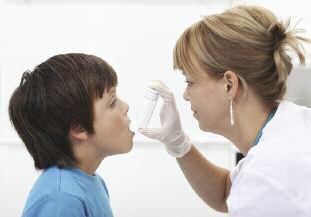New procedures are changing how we treat lung disease.
Heavy breathing is music to Carlos Remolina’s ears. No, it’s not what you think. Dr. Remolina is a man who takes breathing—all breathing—personally. As an asthma sufferer himself, he is in his third decade of practicing pulmonary medicine, treating diseases including chronic bronchitis, asthma, COPD, sleep apnea, pulmonary emphysema, lung cancer, pleural effusions, and other conditions. At Trinitas, Dr. Remolina is breathing new life into his field with procedures that are slashing the length of hospital stays, streamlining procedures and improving patient outcomes, and, of course, saving lives.

Photo credit: iStockphoto/Thinkstock
“It’s very important to me to make a diagnosis as early as possible to save a patient from having to undergo a major surgical procedure,” he says. “So the fact that we’re able to be on the cutting-edge and perform the procedures that are only being done in major medical centers is very rewarding.”
Dr. Remolina’s latest groundbreaking procedures is what he refers to as EBUS: an endobronchial ultrasound. “We can go right to a mass and then an ultrasound allows us to get inside the tumor itself and access areas of the lung we never could,” he says. By performing a bronchoscopy with the help of an ultrasound, he explains, patients need only undergo one procedure that will allow his team to diagnose and treat a bronchial condition—saving them from having to pay a visit to a surgeon and await the results of a biopsy. “The value of this procedure is that now not only can we make a diagnosis of cancer, but we can also stage it—we’ll know right away if the cancer is too advanced to operate and what the most effective method of treatment will be.”
Anyone admitted to Trintias in need of an endobronchial valve treatment can also rest assured that Dr. Remolina will spare them from unnecessary, painful surgeries; his endobronchial valve procedure enables doctors to perform a bronchoscopy and inflate a balloon to locate and stop a leak without the need for an uncomfortable chest tube insertion. “We send the patient home and six weeks later, they can come back to have the valve removed,” he says. “Hospitals are always focused on reducing the length of patient stays, so by taking away the need for patients to remain in the hospital in order for us to monitor a chest tube, we’re making it easier on the patient and preventing them from having to admit themselves for an extended hospital stay.”

Carlos Remolina, MD, FCCP, PA Chief/Pulmonary Diseases, Trinitas Regional Medical Center Director, Care One LTACH 908.241.2030
Dr. Remolina is working to ensure that the entire staff at Trinitas is trained to perform the latest in pulmonary medicine techniques. Among the hospital’s future plans, he says, is the acquisition of a navigational system that will enhance the capabilities of tools such as a bronchoscope. “It’s basically like a GPS that would allow us to find even the smallest tumor and do a biopsy,” he explains. “That way, we can detect cancer sooner and enable surgeons to operate more efficiently and with greater precision. Nobody else around here is doing what we’re doing…our ultimate goal is to provide the best pulmonary medicine in the area.” EDGE
Editor’s Note: Carlos Remolina, M.D., F.C.C.P., P.A. is board-recertified in internal medicine and pulmonary medicine. He currently serves as the division chief of pulmonary diseases at TRMC and medical director of Care One LTACH (Long Term Acute Care Hospital) at Trinitas. He completed medical school at the University of Medicine in Zaragoza, Spain before moving on to complete his residency at the New York Infirmary Hospital. Dr. Remolina completed his fellowship in pulmonary diseases at the New Jersey College of Medicine and Dentistry, Rutgers Medical School in Piscataway. His practice is located in Linden.





